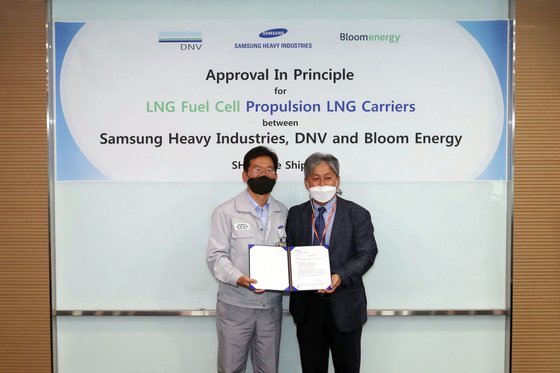Samsung Heavy builds world‘s first fuel cell-powered LNG carrier
By Yim Hyun-suPublished : July 1, 2021 - 15:40

South Korea’s leading shipbuilder Samsung Heavy Industries on Thursday claimed to have built the world’s first solid oxide fuel cell-powered LNG carrier. It will now begin work on commercializing the ship, the firm said.
The company also said it has received an approval in principle from Norwegian and German classification society DNV for the design of the SOFC-powered ship, which has been developed in collaboration with Bloom Energy.
An approval in principle, also known as AIP, is a process to verify technological features of basic marine designs and enable shipbuilders to receive orders by officially approving their technologies and ships.
The new LNG carrier is designed to replace marine propulsion engines as well as internal combustion engines and other devices that run on oil with SOFC.
The innovative design will help prevent toxic chemicals such as sulfur oxides and nitrogen oxides from being released, as well as drastically cutting down on greenhouse gas emissions, the shipbuilder explained, which will be beneficial for the company when keeping in line with environmental regulations.
The latest move follows its joint development agreement with Bloom Energy -- a US company known for its modular fuel cell projects -- to develop a fuel cell in July last year
In 2019, it also received an AIP from DNV for its fuel cell-powered A-max COTs.
Samsung Heavy Industries said it plans to conduct demonstration tests at a testing facility in its Geoje shipyard before it begins marketing efforts to attract global ship owners.
Jeong Ho-hyun, Head of the company’s technology development headquarters, said the new ship is a “new concept” that reduces the emission of air pollution as well as noise and maintenance cost
Efforts to make ships more environmental friendly are likely to continue after the International Maritime Organization set out the plan to reduce carbon emissions by applying the energy efficiency existing ship index and the carbon intensity indicator to pre-existing ships starting from 2023.
The company also said it has received an approval in principle from Norwegian and German classification society DNV for the design of the SOFC-powered ship, which has been developed in collaboration with Bloom Energy.
An approval in principle, also known as AIP, is a process to verify technological features of basic marine designs and enable shipbuilders to receive orders by officially approving their technologies and ships.
The new LNG carrier is designed to replace marine propulsion engines as well as internal combustion engines and other devices that run on oil with SOFC.
The innovative design will help prevent toxic chemicals such as sulfur oxides and nitrogen oxides from being released, as well as drastically cutting down on greenhouse gas emissions, the shipbuilder explained, which will be beneficial for the company when keeping in line with environmental regulations.
The latest move follows its joint development agreement with Bloom Energy -- a US company known for its modular fuel cell projects -- to develop a fuel cell in July last year
In 2019, it also received an AIP from DNV for its fuel cell-powered A-max COTs.
Samsung Heavy Industries said it plans to conduct demonstration tests at a testing facility in its Geoje shipyard before it begins marketing efforts to attract global ship owners.
Jeong Ho-hyun, Head of the company’s technology development headquarters, said the new ship is a “new concept” that reduces the emission of air pollution as well as noise and maintenance cost
Efforts to make ships more environmental friendly are likely to continue after the International Maritime Organization set out the plan to reduce carbon emissions by applying the energy efficiency existing ship index and the carbon intensity indicator to pre-existing ships starting from 2023.





![[Herald Interview] 'Amid aging population, Korea to invite more young professionals from overseas'](http://res.heraldm.com/phpwas/restmb_idxmake.php?idx=644&simg=/content/image/2024/04/24/20240424050844_0.jpg&u=20240424200058)











![[KH Explains] Korean shipbuilding stocks rally: Real growth or bubble?](http://res.heraldm.com/phpwas/restmb_idxmake.php?idx=652&simg=/content/image/2024/04/25/20240425050656_0.jpg&u=)

